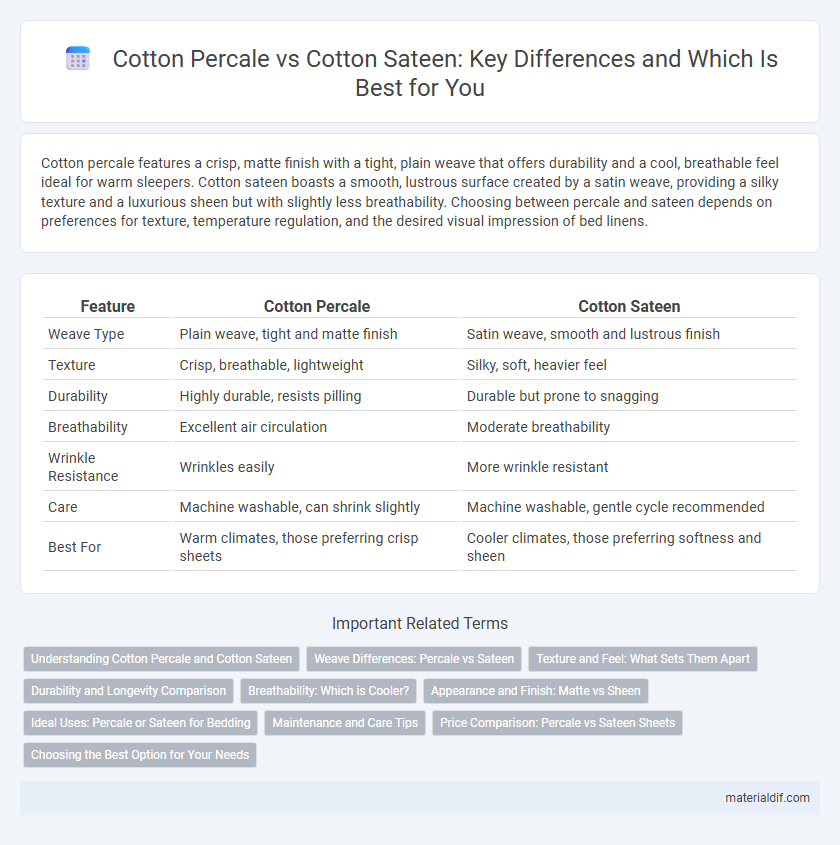Cotton percale features a crisp, matte finish with a tight, plain weave that offers durability and a cool, breathable feel ideal for warm sleepers. Cotton sateen boasts a smooth, lustrous surface created by a satin weave, providing a silky texture and a luxurious sheen but with slightly less breathability. Choosing between percale and sateen depends on preferences for texture, temperature regulation, and the desired visual impression of bed linens.
Table of Comparison
| Feature | Cotton Percale | Cotton Sateen |
|---|---|---|
| Weave Type | Plain weave, tight and matte finish | Satin weave, smooth and lustrous finish |
| Texture | Crisp, breathable, lightweight | Silky, soft, heavier feel |
| Durability | Highly durable, resists pilling | Durable but prone to snagging |
| Breathability | Excellent air circulation | Moderate breathability |
| Wrinkle Resistance | Wrinkles easily | More wrinkle resistant |
| Care | Machine washable, can shrink slightly | Machine washable, gentle cycle recommended |
| Best For | Warm climates, those preferring crisp sheets | Cooler climates, those preferring softness and sheen |
Understanding Cotton Percale and Cotton Sateen
Cotton percale is a lightweight, tightly woven fabric known for its crisp texture and breathable quality, making it ideal for warm climates and those who prefer a matte finish. Cotton sateen, in contrast, features a satin weave that produces a smooth, lustrous surface with a heavier, silky feel and enhanced durability. Both fabrics are made from 100% cotton fibers but differ significantly in weave, texture, and aesthetic appeal, influencing their use in bedding and apparel.
Weave Differences: Percale vs Sateen
Cotton percale features a tight, plain weave with a one-over, one-under pattern, resulting in a crisp, matte finish and durable fabric ideal for breathability and everyday use. Cotton sateen employs a four-over, one-under satin weave, creating a smooth, lustrous surface that feels silky and drapes elegantly but may be less durable than percale. The distinct weave structures define the texture, sheen, and performance of percale and sateen sheets, influencing comfort and maintenance preferences.
Texture and Feel: What Sets Them Apart
Cotton percale features a crisp, matte finish with a tight, plain weave that provides a cool, breathable texture ideal for warm climates. Cotton sateen offers a smooth, lustrous surface with a satin weave that feels silky and soft against the skin, giving it a luxurious warmth. The distinct weave patterns of percale and sateen directly influence their tactile characteristics, making percale more lightweight and sateen more substantial.
Durability and Longevity Comparison
Cotton percale is tightly woven with a plain weave, resulting in a crisp, durable fabric that withstands frequent washing and maintains its strength over time. Cotton sateen features a satin weave, offering a silky feel but with slightly less durability due to its looser weave structure, making it more prone to wear and pilling. For long-lasting bedding, cotton percale provides superior longevity and resilience compared to the softer but more delicate cotton sateen.
Breathability: Which is Cooler?
Cotton percale offers a crisp, lightweight weave that enhances airflow and maximizes breathability, making it a cooler option for hot sleepers. Cotton sateen, with its denser weave and silky finish, tends to trap more heat, providing a warmer sleep environment. Choosing between percale and sateen depends on whether you prioritize cool breathability or soft warmth in your bedding.
Appearance and Finish: Matte vs Sheen
Cotton percale features a matte finish with a crisp, smooth texture ideal for a clean, understated look in bedding. Cotton sateen offers a lustrous sheen and silky feel due to its satin weave, giving fabrics a subtle shine and a luxurious appearance. The difference in weave patterns directly influences the fabric's surface texture and visual appeal, making percale better for those who prefer a matte finish and sateen suited for those desiring a glossy, elegant look.
Ideal Uses: Percale or Sateen for Bedding
Cotton percale is ideal for lightweight, breathable bedding suited to warm climates or hot sleepers, offering a crisp, matte finish that stays cool through the night. Cotton sateen, with its smooth, lustrous surface and tighter weave, provides a luxurious, silky feel perfect for cooler temperatures and those seeking soft, silky sheets with a slight sheen. Choosing percale enhances breathability and durability, while sateen prioritizes warmth and a silky touch, making both fabrics excellent options depending on personal comfort preferences and seasonal needs.
Maintenance and Care Tips
Cotton percale fabric features a crisp, matte finish that requires regular washing in cold water and low heat drying to maintain its texture and prevent shrinkage. Cotton sateen, characterized by its smooth, lustrous surface, benefits from gentle washing cycles and air drying or low-temperature tumble drying to preserve its sheen and softness. Both fabrics avoid bleach and fabric softeners to extend their lifespan and retain fabric integrity.
Price Comparison: Percale vs Sateen Sheets
Cotton percale sheets typically cost less than cotton sateen due to their simpler weave and lower manufacturing complexity. Percale offers a crisp, lightweight feel that appeals to budget-conscious buyers, while sateen's smooth, lustrous finish commands a higher price point reflecting its luxury status. Price differences often range from 15% to 30%, with sateen sheets positioned as premium bedding options.
Choosing the Best Option for Your Needs
Cotton percale features a crisp, matte finish with a tight, plain weave that offers durability and breathability, making it ideal for those seeking a cool, lightweight fabric. Cotton sateen has a smooth, lustrous surface due to its satin weave, providing a silky feel and a bit more warmth, suitable for users wanting a more luxurious and soft touch. Selecting between cotton percale and cotton sateen depends on personal preferences related to texture, temperature regulation, and desired fabric longevity.
Cotton Percale vs Cotton Sateen Infographic

 materialdif.com
materialdif.com